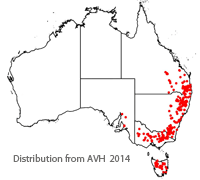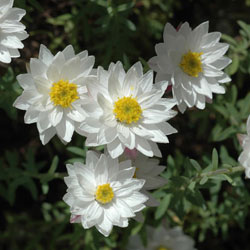Rhodanthe anthemoides
Chamomile Sunray
Rhodanthe anthemoides (Sieber ex Spreng.) Paul G.Wilson
Rhodanthe anthemoides, commonly known as Chamomile Sunray, is a small compact native Australian daisy (family Asteraceae) with abundant white flowers and dark green foliage growing to between 15 and 30 cm tall.
 Rhodanthe anthemoides is widespread in eastern Australia and Tasmania. It grows chiefly in montane rocky areas, preferring sandy soils. Depending on locality, rose-pink buds will form during winter and stay dormant, opening in early spring to summer. Its most active time for bud formation is winter and therefore it can brighten up a garden at this time of year when other plants may be less productive. For ideal growth and flowering, plants should be placed on the eastern side of the garden so that morning sun is received.
Rhodanthe anthemoides is widespread in eastern Australia and Tasmania. It grows chiefly in montane rocky areas, preferring sandy soils. Depending on locality, rose-pink buds will form during winter and stay dormant, opening in early spring to summer. Its most active time for bud formation is winter and therefore it can brighten up a garden at this time of year when other plants may be less productive. For ideal growth and flowering, plants should be placed on the eastern side of the garden so that morning sun is received.
In order to maintain a leafy form and encourage onset of second flowering trim the plant after the first flowers have withered. At this time it is also ideal to fertilise with sulphate or potash, increasing the chances of new flowers being formed. Fertiliser may also be applied in autumn as this is when most active plant growth takes place. Watering should ideally occur every three days to prevent dieback, and may need to be increased in very dry or hot weather.
Propagation is simple with new stock being easily grown from cuttings. Simply cut a 5 to 10 cm piece, strip the bottom 3 cm of its leaves, dip it in a suitable rooting hormone to encourage root formation and place in water, ensuring that no leaves are submerged. Cuttings should then be stood where they receive light and the water changed daily. Roots will then form usually in 3–12 weeks time and cuttings may then be carefully placed in soil.
Cultivated forms are more leafy and bulky than natural types and are bred for a compact bushy appearance with many flowers. Propagation from cuttings is the preferred method for maintaining the cultivated qualities, as propagation from seed can result in plants that are dramatically different from parent plants. However if growing from seed is preferred planting is best done between autumn to spring.
Rhodanthe anthemoides may be difficult to keep alive in summer at lower altitudes and will require a lot of water and pruning, however re-sprouting can occur once temperatures cool off. This plant will not tolerate deep shade or extremely dry and hot climates. It grows ideally in deep garden beds but will tolerate shallow sandy soils provided fertiliser and water are adequate.
Text by Eleanor Velasquez (2014 Student Botanical Intern).
Name meaning: Rhodanthe anthemoidesRhodanthe – derived from the Greek words rhodo (rose-coloured) and anthos (flower). anthemoides – similar to the chamomile genus, Anthemis |
References:
Costin, A., Gray, M., Totterdell, C. & Wimbush, D. (2000) Kosciuszko Alpine Flora, 2nd edn. CSIRO Publishing.
Harden, G. (1992) Flora of New South Wales, Volume 3, University of NSW Press, Kensington.
Amber Howe (2014) Horticulturalist, ANBG. Personal Communication.
Barker, J., Greig, J, Peate, N., Courtney, B., Salkin, E., Schauman, M., Armstrong, J. & Thomlinson, G. (2002) Everlasting Daisies of Australia: Identification, Propagation and Cultivation. C. H. Jerram & Associates, Science Publishers, Victoria.
![An Australian Government Initiative [logo]](/images/austgovt_brown_90px.gif)



